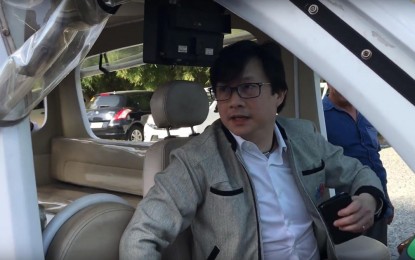
MASS TRANSPORT. Presidential Assistant for the Visayas Michael Lloyd Dino tries a modern passenger jeepney manufactured by Star-8 Green Technology Corp. which shall be rolled out in Metro Cebu. (Photo courtesy of the Office of the Presidential Assistant for the Visayas)
CEBU CITY – The need to catch up with the development of Metro Cebu has motivated the Duterte administration to come up with a mass transport system that should be operational come 2020, Presidential Assistant for the Visayas Michael Lloyd Dino on Thursday told the Philippine News Agency.
This, as the Draft Philippine Transportation System Masterplan mentioned Cebu’s economic development which “steadily expanded from 6 percent to 7 percent GDP (gross domestic product) in 15 years.”
To be constructed under the Duterte administration’s "Build, Build, Build" program, Dino said the Light Rail Transit (LRT) which is expected to break ground in the first quarter of 2019, is seen to cope with the pressing demand for a mass transport system in the metropolis.
“We need to act now. Or else we will see an exploding city due to growing number of passengers that could no longer be accommodated with the existing modalities right now,” Dino said.
In his presentation before the recent Regional Development Committee (RDC-7) Infrastructure Development Committee meeting, Dr. Seng Felias, assistant team leader of the Transport and Traffic Planners Inc. (TTPI) , told the committee members that 80 percent of Cebu’s population is concentrated in Metro Cebu.
Felias said the growth sectors are “concentrated over a 75-kilometer radius spanning the cities of Talisay, Cebu, Mandaue, and Lapu-Lapu.”
“The metro’s population is projected to reach 5 million by year 2050,” he noted.
According to Felias, the 2015 JICA (Japan International Cooperation Agency) roadmap study identified congested intersections which coincided with the 2010 JICA study.
The 2015 JICA study, he said, “recommended improvements at heavily congested intersections involving structural and non-structural interventions similar to the 2010 JICA study".
Felias also cited a DPWH traffic impact study of Cebu city intersections which discovered five congested intersections which were also identified by the JICA studies. These are the M.J. Cuenco Avenue – Gen. Maxilom Avenue; Gorordo Avenue – Archbishop Reyes Avenue; Gen. Maxilom Avenue – Gorordo Avenue; Gen. Maxilom Avenue – F. Sotto Drive – D. Jakosalem Street; and Gorordo Avenue – N. Escario Avenue.
The studies also revealed that “narrow physiography along the coastal floodplains have historically defined Metro Cebu’s ribbon-type urban densification".
“Its intermodal facilities are all located in this economic and transport confluence” such as the international airport, ports, and economic zones all linked by arterial roads, it further revealed.
Physical accumulation of vehicle traffic results in the congestion along arterial roads over the urban radius, the studies concluded.
Dino said that if there is no efficient mass transport system in the next five years, the economic impact in the congestions of Metro Cebu roads and intersections will become unbearable to Cebuanos and visitors alike.
"We know the physiography of our existing road networks vis-a-vis our existing transport systems available. These are becoming irrelevant already," he said.
The presidential assistant for the Visayas cited a Philippine Star report which said that Udenna Corp. of businessman Dennis Uy and its foreign partners have submitted a revised unsolicited proposal for the development of a Cebu LRT project.
The latest version of the proposal would entail a total investment of $1.5 billion, lower by half from the original proposal, he said.
The revised proposal includes priority lines that will include the central line and the airport line.
Dino said Cebuano commuters will have a taste of modern mass transport system in 2020 yet, when they should have been using them some 10 years ago.
He also pushed for the modernization of public utility jeepneys in Metro Cebu so that the LRT will have a feeder line towards the interior of this city and the neighboring cities and towns where the rail system will have its stations. (PNA)
